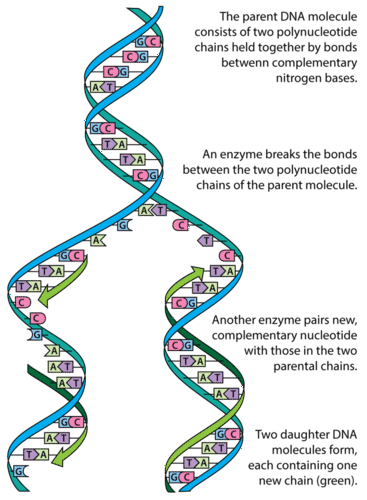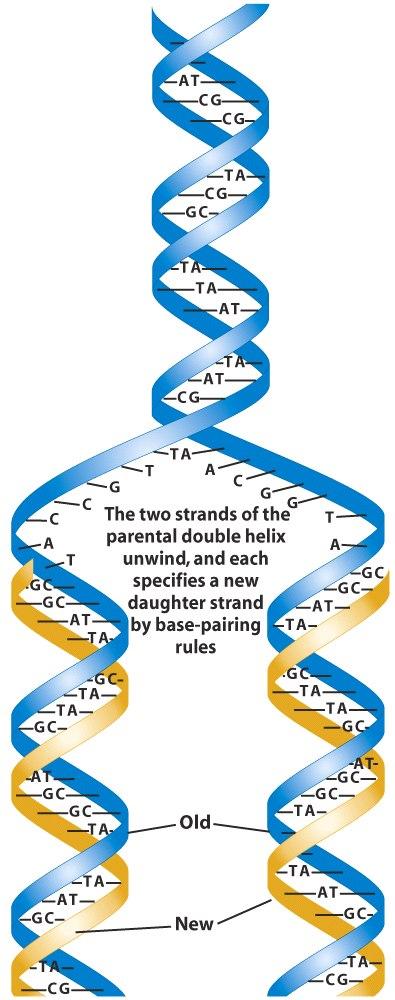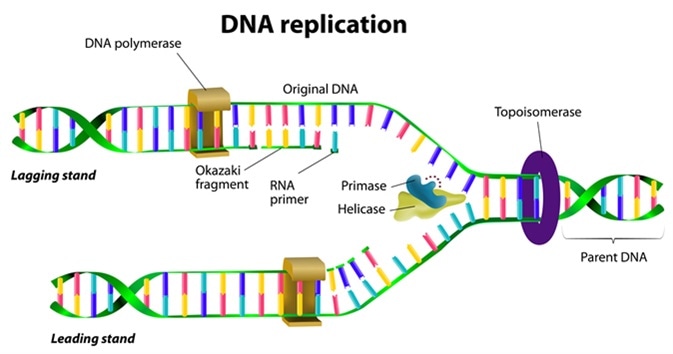Describe the Process of Dna Replication.
When a cell divides it must first duplicate its genome so that each daughter cell winds up. The process of DNA replication can be summarized as follows.

Dna Replication Advanced Ck 12 Foundation
McGraw Hi Education leading nontemplate DNA ligase hydrogen identical replication fork helicase continuously discontinuously covalent Okazaki fragments Sister chromatins template DNA polymerase lagging Step 1 The molecule are broken by bonds between the complementary base nucleotides of the double helix exposing the nitrogenous bases Step 2 The separation of.

. What Are The 5 Steps Of Dna Replication In Order. This is accomplished by the process of DNA replication. During cell division these copies get distributed in the two daughter cells.
As parental DNA is partly conserved in each daughter DNA the process of replication is called semi-conservative. Points eBook References -A. Enzyme ____ catalyzes the unwinding of DNA double helix.
Describe the process of DNA replication. When a cell divides it is important that each daughter cell receives an identical copy of the DNA. DNA unwinds at the origin of replication.
During DNA replication molecules that line up along the unpaired DNA strands holding them apart while the DNA strands serve as templates for the synthesis of complimentary strands of DNA Explain the roles of DNA polymerase mismatch repair enzymes and nuclease in DNA proofreading and repair. DNA Helicase Okazaki Fragments etc. CG -TA GC G C ETA- AT CG AT GC GC- TA b.
Answers may be used more than once. An Overview of DNA Replication. Imagine there is an unlabelled diagram in front of you to guide your explanation.
AT C G. DNA replication in 7 easy steps. DNA replication is a multistep process where new DNA is made.
The process of DNA replication occurs by the following three steps. Single-strand binding proteins coat the DNA around the replication fork to prevent rewinding of the DNA. Use the terms free nucleotides helicase polymerase complementary.
The four types of nucleotides of DNA ie. DNA replication occurs due to an enzyme. Helicase enzyme breaks hydrogen bonds between bases unzips and unwinds the helix A protein that catalyzes chemical reactions.
The central enzyme involved is DNA polymerase which catalyzes the joining of deoyribonucleoside 5-triphosphates dNTPs to form the growing DNA chain. These are extended in both directions. They are activated by ATP in presence of an enzyme phosphorylase.
Inside the replication bubble the Y-shaped replication fork is formed from where the replication process starts and proceeds bidirectionally. Topoisomerase helps relieve the strain ahead of ____ caused by unwinding of DNA. DAMP dGMP dCMP and dTMP are present in the nucleoplasm.
This exposes complementary bases on. Describe the process in which DNA replication occurs 6 marks Firstly the enzyme DNA helicase separates the two strands in DNA by breaking the hydrogen bonds between them. The DNA unzips and the enzyme pieces together.
The replication of DNA occurs before the cell begins to divide into two separate cells. In the DNA strand each base can only bind to its complementary base. Both of the two strands then act as templates to which free nucleotides attach to.
As a part of the cell cycle the cell makes 2 copies of the DNA. DNA replication in eukaryotes is multi-replicon ie it has many origins of replication. DNA Replication begins at the Origin of Replication.
This exposed the bases that are typically the rungs of the double helix. The first step in DNA replication is to unzip the double-helix structure of the DNA molecule. Describe the process of DNA replication as if explaining it to a fellow classmate.
The discovery and characterization of the structure of the double helix provided a hint as to how. This attachment occurs by complementary base pairing where cytosine and guanine bases join and adenine and thymine. Describe the process of DNA replication according to the semi-conservative theory.
DNA replication is the biological process in which two identical copies of DNA are produced from one original DNA molecule. Try to include as many relevant proteins and concepts as possible to help demonstrate an understanding eg. So each strand of DNA acts as a template and codes for the other strand.
Helicase opens up the DNA-forming replication forks. DNA replication is the process by which a cell makes an identical copy of its DNA. The ____ between the bases in DNA are broken.
Helicase begins to unwind the DNA at the ORIGIN OF REPLICATION a specific DNA nucleotide sequence Its common to only show one strands. Second now that the bases are open DNA polymerase will bring new nucleotides. Nature of DNA replication Keyboard Navigable Alternate Version 8 Choose the correct answer for the below image to describe the process of DNA replication.
PLEASE HELPPP 1 Briefly describe the process of DNA replication. So multiple bubbles are formed and then fuse which results in speeding up the replication of long DNA molecule. Unwinds one strand from a double helix to expose its nucleotide bases.
A Start with the molecular machinery and be sure to describe what DNA polymerase does. DNA replication is the process of producing two identical copies of DNA in which each template for the synthesis of a new complementary daughter strand. DNA replication is the process by which a molecule of DNA is duplicated.
First the double helix is unzipped using DNA helicase. Single-strand binding protein bind to. Mechanism of replication is as follows.
The steps involved in the process of DNA replication are as follows.

What Are The Steps Of Dna Replication


Comments
Post a Comment